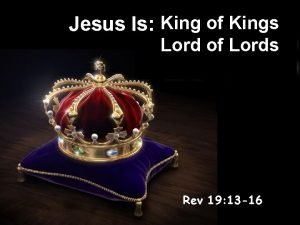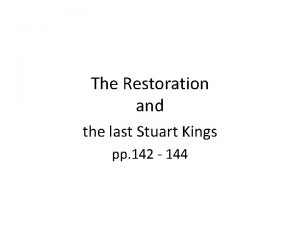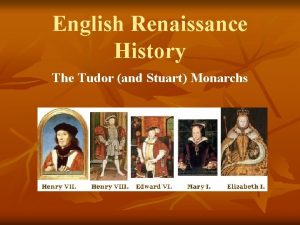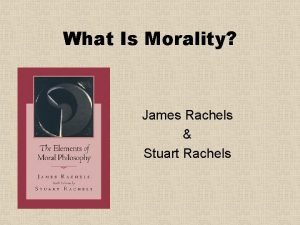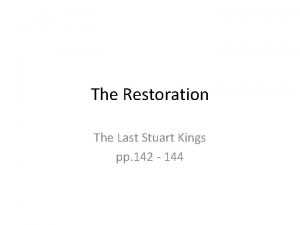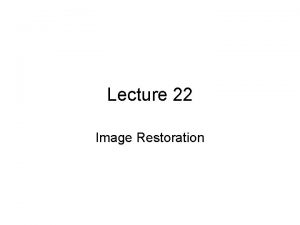The Restoration and the last Stuart Kings pp






- Slides: 6

The Restoration and the last Stuart Kings pp. 142 - 144

• • • Restoration = restoration of the monarchy after the Commonwealth period (1649 – 1658) in England; Charles II (1660 – 85) 1658 – Cromwell’s death. 1658 – 1660 period of political instability; 1660 – Charles II, the legitimate heir of the Stuart dynasty is offered the English throne by the Parliament; The return of the Stuart monarchy is initially welcomed by the British people; Charles II reigns as absolute monarch; first two measures taken by Charles II: – reasserting the predominance of the Church of England; – dissolution of the Parliament. 1665 – Great Plague (about 70, 000 people die of plague only in London); 1666 Great Fire of London: most of the city is destroyed.

James II (1685 – 88) • James II – follows his brother’s principles in political matters – believes in the divine right to rule over the country; – refuses to consult the Parliament; – in religious matters he is a Catholic; – adopts a policy in favour of Catholics; – appoints Catholics to positions of responsibility and power within the state; • Plot against the king: James II is deposed and in his place, William of Orange, the defender of Protestantism throughout Europe and the husband of Mary, James II’s Protestant daughter, is called in.

James II (1685 – 88) Glorious Revolution • 5 November 1688 – William of Orange lands in England with a small force; • 1689: William and Mary become king and queen of England • 1694: Mary’s death; William rules alone the country with the title of William III; Introduction of important Acts • 1689: Bill of Rights – the monarch cannot rule without the support of the Parliament; • 1689: Toleration Act – Dissenters (Puritans) are granted freedom of religion; • 1701: Act of Settlement: only Puritan monarchs can rule the country.

Queen Ann (1702 – 14) • James II’s younger Protestant daughter; • last monarch of the Stuart family to rule the country; • 1707 – Act of Union: the Scottish and English Parliaments become one Parliament set in London; • 1701 – 1714: War of the Spanish Succession England joins Prussia and the Netherlands against France, Spain and Portugal to protect the country’s interests abroad. • 1713 – Treaty of Utrecht – peace with France and Spain • advantages obtained by Great Britain: – British influence in the Mediterranean is guaranteed thanks to the possessions of Gibraltar and Minorca; – Maritime control of Canada is guaranteed thanks to the acquisition of Acadia, Hudson Bay and the island of Newfoundland; – Permission to send a ship every year to trade with Spanish South. American colonies – first step towards commercial penetration in the rich South-American market; – Monopoly of the African slave trade for the North-American colonies. •

Britain’s foreign policy at the beginning of XVIII century • Protecting and increasing commercial interest broad; • 1694 - foundation of a national bank: the “Bank of England”; • The “Bank of England” attracts private capital paid by the State at a low rate of interest; • This private capital is used by the Government to put its policy into practice
